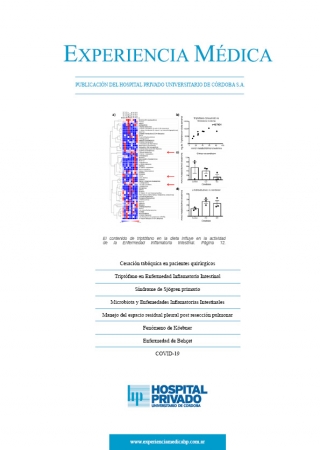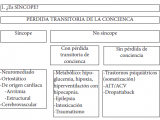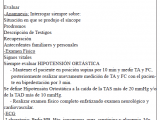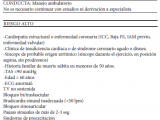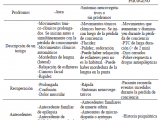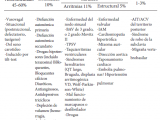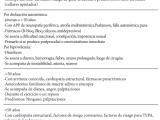Volumen 30, Nº 2 | 2012
Consenso sobre algoritmo diagnóstico de síncope - Consensus on Syncope diagnostic algorithm
Sabina Halac, Marcelo A. Villafañe, Andrés Caeiro, Alejandro Contreras, Ricardo Albertini
Palabras clave:
Keywords:
Síncope
Pérdida transitoria de la conciencia y del tono postural, debido a hipoperfusión cerebral, de inicio rápido, duración corta y recuperación espontánea y completa.
Evaluación inicial del paciente con síncope
1.¿Es SÍNCOPE? (Figura 1)
2.La historia nos orienta a algún diagnóstico etiológico? ¿Hay PATOLOGÍA CARDÍACA? (Figura 2)
3.Estratificar el RIESGO. Evaluar internación vs. Manejo ambulatorio (Figura 3)
PRINCIPALES DIAGNÓSTICOS DIFERENCIALES DE SÍNCOPE (Tabla 1)
CAUSAS DE SÍNCOPE (Tabla 2)
CARACTERÍSTICAS CLÍNICAS (Tabla 3)
CONDUCTA: Internación en cama fría, en sala común o UCIC. Tratamiento según la causa.
- Alteraciones en laboratorio: Buscar la causa. Tratar.
- Hipovolemia: Buscar la causa. Tratar.
- Síncope de origen cardíaco de alto riesgo: monitorizar. Buscar etiología.
- Síncope de origen cerebrovascular (poco frecuente): Interconsulta con servicio de neurología. Si la causa del síncope es poco clara, se requiere igualmente valoración cardiovascular.
Bibliografía
1. Brignole M, Hamdan MH. New concepts in the assessment of syncope. J Am CollCardiol. 2012 May 1;59(18):1583-91.2. Brignole M, Menozzi C, Bartoletti A, Giada F, Lagi A, Ungar A, Ponassi I, Mussi C, Maggi R, Re G, Furlan R, Rovelli G, Ponzi P, Scivales A. A newmanagement of syncope: prospective systematic guideline-based evaluation of patients referred urgently to general hospitals. Eur Heart J. 2006 Jan;27(1):76-82. Epub 2005 Nov 4
3. Consenso para el diagnóstico y tratamiento del síncope. Sociedad
Argentina de cardiología. Revista Argentina de Cardiología. Vol 80 N1. Enero –Febrero 2012. 3. Consenso para el diagnóstico y tratamiento del síncope. Sociedad Argentina de cardiología. Revista Argentina de Cardiología. Vol 80 N 1. Enero–Febrero 2012.
4. Cooper PN, Westby M, Pitcher DW, Bullock I. Synopsis of the National Institute for Health and Clinical Excellence Guideline for management of transient loss of consciousness. Ann Intern Med. 2011 Oct 18;155(8):543-9.
5. Kessler C, Tristano JM, De Lorenzo R. The emergency department
approach to syncope: evidence-based guidelines and prediction rules. Emerg Med Clin North Am.2010 Aug;28(3):487-500.
6. National Clinical Guideline Centre for Acute and Chronic Conditions (UK).Transient Loss of Consciousness (‘Blackouts’)
Management in Adults and Young People [Internet]. London: Royal College of Physicians (UK); 2010 Aug. Available from http://www.ncbi.nlm.nih.gov/books/NBK63820/
7. Ouyang H, Quinn J. Diagnosis and evaluation of syncope in the emergency department. Emerg Med Clin North Am. 2010 Aug;28(3):471-85.
8. Petkar S, Cooper P, Fitzpatrick AP. How to avoid a misdiagnosis in patients presenting with transient loss of consciousness. Postgrad Med J. 2006 Oct;82(972):630-41. Review.
9. Quinn J, McDermott D, Stiell I, Kohn M, Wells G. Prospective validation of theSan Francisco Syncope Rule to predict patients with serious outcomes. AnnEmerg Med 2006;47:448–454.
10. Smars PA, Decker WW, Shen WK. Syncope evaluation in the emergency department. CurrOpinCardiol. 2007 Jan;22(1):44-8. Review.
11. Task Force for the Diagnosis and Management of Syncope; European Society of Cardiology (ESC); European Heart Rhythm Association (EHRA); Heart Failure Association (HFA); Heart Rhythm Society (HRS), Moya A, Sutton R, Ammirati F, Blanc JJ, Brignole M, Dahm JB, Deharo JC, Gajek J, Gjesdal K, Krahn A, Massin M, Pepi M, Pezawas T, Ruiz Granell R, Sarasin F, Ungar A, van Dijk JG, Walma EP, Wieling W. Guidelines for the diagnosis and management of syncope (version 2009). Eur Heart J. 2009 Nov;30(21):2631-71.
